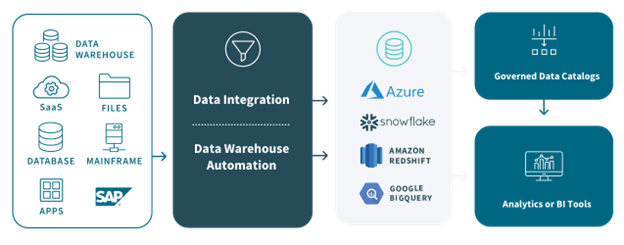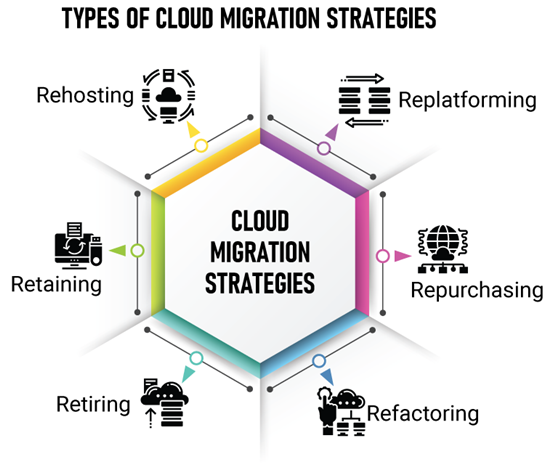Cloud Advisory:
Today, cloud has become enabler for digital transformation and a catalyst for business innovation for enterprises and SME. For enterprises charting their growth path in an ever dynamic business, there is greater focus and drive for digital strategy to service their clients in best possible manner. Furthermore, this needs to be done in with least disruption in business without compromising resiliency, security, and compliance.

Our cloud experts evaluate customer existing setups, business requirements and project objectives in detail. Upon evaluation, we suggest healthy mix of public, private, and hybrid cloud solutions that best serve customer needs. We build cloud adoption roadmaps supported by cloud readiness framework to achieve greater business returns.
Our analysis of your project can help you leverage technology to achieve key business objectives. We
help you in identifying the workloads & applications that are cloud-ready and develop an appropriate
deployment strategy. This consists of a wide spectrum of choices across hybrid/public/private,
IaaS/PaaS/SaaS, and cloud-native/agnostic solutions.
Migration strategies developed by our experts are tailored for your business. We help you meet your
transformation objectives effectively along with improving the overall IT security, governance, and
management. Our expertise can help you build a robust foundation for your cloud transformation.
We help our clients drive change by designing an operating model that helps enterprises embrace the move to cloud. We help set up a digital transformation office, define a roadmap and mature operating model. We also view cloud security as integral part of operating model rather than something that is an after though.
Controlling spend has become major aspect for cloud first organization and has got equal importance as that of cloud security. Today, enterprises seek regular guidance on managing cloud spends. Our cloud cost optimization framework embraces all critical aspects of cloud operations and brings together perspectives from technology, finance, security and the business. We help our clients build robust Cloud Economics Management competencies that make cloud from a cost center to a value creator for organization.
Cost Optimization & Governance

There is some inherent waste in your cloud spending and customers want to address that. Cloud cost
management and optimization are becoming “Significant tasks” in today’s cloud world. All major cloud
OEMs understand this and provide their native solutions for cost optimization.
Cloud cost optimization is important because customers want to maximize business benefits by
optimizing their cloud spend. Customers want to pay for cloud resources that deliver the most added
value for your business. By using the best practices of cloud cost optimization one can reduce cloud
waste.
The goal of cloud governance is to enhance data security, manage risk, and enable the smooth operation
of cloud systems. Cloud governance ensures that asset deployment, system integration, data security
and other aspects of cloud computing are properly planned, considered, and managed. This is highly
dynamic, because cloud systems can be created and maintained by different groups in the organization,
involve third-party vendors, and can change on a daily basis.
done_all
Compliance with cloud policy —
cloud consumption standards must be consistent with
regulations and compliance standards used by the organization and must be in line with industry
norms.
done_all
Collaboration —
There should be clear agreements between owners and users of cloud
infrastructure, and other stakeholders in the relevant organizational units, to ensure they make
appropriate and mutually beneficial use of cloud resources.
done_all
Change management —
All changes to a cloud environment must be implemented in a consistent
and standardized manner, subject to the appropriate controls.
done_all
Dynamic response —
Cloud governance should rely on monitoring and cloud automation to
dynamically respond and recover from events in the cloud environment.
We also support customers with 3rd party tools which can automatically execute precise instance
rightsizing across types, families and regions, using AI-based pattern recognition and ML inference.
Cloud Architecture Review
To ensure customers are getting the most out of their investments, at the same time keeping their data
and business secure, its essential to get a complete picture of the entire cloud architecture
AWS‘s Well-Architected Framework is a widely accepted model that follows six pillars of software
quality to help organizations achieve operational excellence from their cloud environments. The
framework’s methods can be applied regardless of which cloud provider you use to manage your
applications.
Armed with AWS's Well-Architected Framework and our best practices, we'll provide recommendations
to optimize your workload. Our team has worked with countless organizations looking to grow on AWS.
How It Works ?
The Cloud Architecture Review is designed to get you maximum from your cloud.

Setting the stage : During this 60 minute introductory call, we will identify and agree which workload
will be scrutinized and learn how it impacts your business. We understand the best ways to align your
business goals with your cloud adoption strategy.
Deep Dive: Our Cloud Architects will dig in deep to learn your team's pain points, workflows, preferred
tool sets, and goals to design a custom Cloud Adoption Roadmap designed to put you on the right path
for growth.
Cloud optimization roadmap: Basis our findings, we prepare detailed cloud optimization roadmap and
present our findings to customer. During workshop these findings are discussed at length and explained
in details. The report also covers current and desired states of the architecture with severity
categorization.
Delivery milestones: Report also contains a project plan defining steps to be taken to achieve
customer’s end objective.
The operational excellence pillar focuses on running and monitoring systems, and continually improving processes and procedures. Key topics include automating changes, responding to events, and defining standards to manage daily operations.
The performance efficiency pillar focuses on structured and streamlined allocation of IT and computing resources. Key topics include selecting resource types and sizes optimized for workload requirements, monitoring performance, and maintaining efficiency as business needs evolve.
The security pillar focuses on protecting information and systems. Key topics include confidentiality and integrity of data, managing user permissions, and establishing controls to detect security events.
The reliability pillar focuses on workloads performing their intended functions and how to recover quickly from failure to meet demands. Key topics include distributed system design, recovery planning, and adapting to changing requirements.
The cost optimization pillar focuses on avoiding unnecessary costs. Key topics include understanding spending over time and controlling fund allocation, selecting resources of the right type and quantity, and scaling to meet business needs without overspending.
The sustainability pillar focuses on minimizing the environmental impacts of running cloud workloads. Key topics include a shared responsibility model for sustainability, understanding impact, and maximizing utilization to minimize required resources and reduce downstream impacts.


